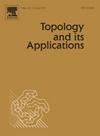对极端不连通拓扑群的两个观察
IF 0.5
4区 数学
Q3 MATHEMATICS
引用次数: 0
摘要
通过修改Malykhin的方法,我们在不可数布尔群([ω1]<ω,≤)上构造了两个非离散且极度不连通的Hausdorff群拓扑。这是通过在ZFC和Jensen的钻石原理下工作来完成的。第一个具有这样的性质:所有形式为[ω1∈α]<;ω的子群都是稠密的,并且[ω1]<;ω的所有可数子集都是封闭的和离散的。这回答了C.A. Martínez-Ranero和U.A. Ramos-García提出的问题[7,问题3.4]。第二种方法的性质是,某些子群(具有子空间拓扑)不能完全断开连接。这回答了Arhangel'skii和Tkachenko [2, Open Problems 4.5.1]提出的问题。本文章由计算机程序翻译,如有差异,请以英文原文为准。
Two observations on extremally disconnected topological groups
By modifying a method of Malykhin's, we construct two Hausdorff group topologies on the uncountable Boolean group which are both nondiscrete and extremally disconnected. This is accomplished by working under ZFC plus Jensen's Diamond Principle. The first one has the property that all subgroups of the form are dense and all countable subsets of are closed and discrete. This answers a question posed by C.A. Martínez-Ranero and U.A. Ramos-García [7, Question 3.4]. The second one has the property that some subgroup (endowed with the subspace topology) fails to be extremally disconnected. This answers a question posed by Arhangel'skii and Tkachenko [2, Open Problems 4.5.1].
求助全文
通过发布文献求助,成功后即可免费获取论文全文。
去求助
来源期刊
CiteScore
1.20
自引率
33.30%
发文量
251
审稿时长
6 months
期刊介绍:
Topology and its Applications is primarily concerned with publishing original research papers of moderate length. However, a limited number of carefully selected survey or expository papers are also included. The mathematical focus of the journal is that suggested by the title: Research in Topology. It is felt that it is inadvisable to attempt a definitive description of topology as understood for this journal. Certainly the subject includes the algebraic, general, geometric, and set-theoretic facets of topology as well as areas of interactions between topology and other mathematical disciplines, e.g. topological algebra, topological dynamics, functional analysis, category theory. Since the roles of various aspects of topology continue to change, the non-specific delineation of topics serves to reflect the current state of research in topology.
At regular intervals, the journal publishes a section entitled Open Problems in Topology, edited by J. van Mill and G.M. Reed. This is a status report on the 1100 problems listed in the book of the same name published by North-Holland in 1990, edited by van Mill and Reed.

 求助内容:
求助内容: 应助结果提醒方式:
应助结果提醒方式:


